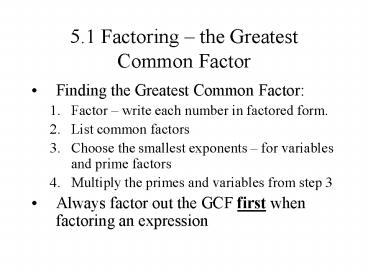5.1 Factoring - PowerPoint PPT Presentation
1 / 23
Title:
5.1 Factoring
Description:
5.1 Factoring the Greatest Common Factor Finding the Greatest Common Factor: Factor write each number in factored form. List common factors – PowerPoint PPT presentation
Number of Views:124
Avg rating:3.0/5.0
Title: 5.1 Factoring
1
5.1 Factoring the Greatest Common Factor
- Finding the Greatest Common Factor
- Factor write each number in factored form.
- List common factors
- Choose the smallest exponents for variables and
prime factors - Multiply the primes and variables from step 3
- Always factor out the GCF first when factoring an
expression
2
5.1 Factoring the Greatest Common Factor
- Example factor 5x2y 25xy2z
3
5.1 Factoring Factor By Grouping
- Factoring by grouping
- Group Terms collect the terms in 2 groups that
have a common factor - Factor within groups
- Factor the entire polynomial factor out a
common binomial factor from step 2 - If necessary rearrange terms if step 3 didnt
work, repeat steps 2 3 until you get 2 binomial
factors
4
5.1 Factoring Factor By Grouping
- ExampleThis arrangement doesnt work.
- Rearrange and try again
5
5.2 Factoring Trinomials
- Factoring x2 bx c (no ax2 term yet)Find 2
integers product is c and sum is b - Both integers are positive if b and c are
positive - Both integers are negative if c is positive and b
is negative - One integer is positive and one is negative if c
is negative
6
5.2 Factoring Trinomials
- Example
- Example
7
5.3 Factoring Trinomials Factor By Grouping
- Factoring ax2 bx c by grouping
- Multiply a times c
- Find a factorization of the number from step 1
that also adds up to b - Split bx into these two factors multiplied by x
- Factor by grouping (always works)
8
5.3 Factoring Trinomials Factor By Grouping
- Example
- Split up and factor by grouping
9
5.3 More on Factoring Trinomials
- Factoring ax2 bx c by using FOIL (in reverse)
- The first terms must give a product of ax2 (pick
two) - The last terms must have a product of c (pick
two) - Check to see if the sum of the outer and inner
products equals bx - Repeat steps 1-3 until step 3 gives a sum bx
10
5.3 More on Factoring Trinomials
- Example
11
5.3 More on Factoring Trinomials
- Box Method (not in book)
12
5.3 More on Factoring Trinomials
- Box Method keep guessing until cross-product
terms add up to the middle value
13
5.4 Special Factoring Rules
- Difference of 2 squares
- Example
- Note the sum of 2 squares (x2 y2) cannot be
factored.
14
5.4 Special Factoring Rules
- Perfect square trinomials
- Examples
15
5.4 Special Factoring Rules
- Difference of 2 cubes
- Example
16
5.4 Special Factoring Rules
- Sum of 2 cubes
- Example
17
5.4 Special Factoring Rules
- Summary of Factoring
- Factor out the greatest common factor
- Count the terms
- 4 terms try to factor by grouping
- 3 terms check for perfect square trinomial. If
not a perfect square, use general factoring
methods - 2 terms check for difference of 2 squares,
difference of 2 cubes, or sum of 2 cubes - Can any factors be factored further?
18
5.5 Solving Quadratic Equations by Factoring
- Quadratic Equation
- Zero-Factor PropertyIf a and b are real numbers
and if ab0then either a 0 or b 0
19
5.5 Solving Quadratic Equations by Factoring
- Solving a Quadratic Equation by factoring
- Write in standard form all terms on one side of
equal sign and zero on the other - Factor (completely)
- Set all factors equal to zero and solve the
resulting equations - (if time available) check your answers in the
original equation
20
5.5 Solving Quadratic Equations by Factoring
- Example
21
5.6 Applications of Quadratic Equations
- This section covers applications in which
quadratic formulas arise.Example Pythagorean
theorem for right triangles (see next slide)
22
5.6 Applications of Quadratic Equations
- Pythagorean Theorem In a right triangle, with
the hypotenuse of length c and legs of lengths a
and b, it follows that c2 a2 b2
c
a
b
23
5.6 Applications of Quadratic Equations
- Example
x2
x
x1































